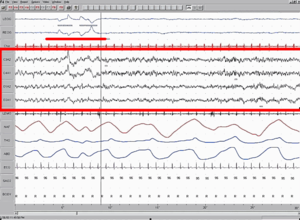聯結主義

聯結主義(粵拼:lyun4 git3 zyu2 ji6;英文:connectionism)係喺廿世紀中後期興起嘅一種認知科學(cognitive science)觀點,主張心靈可以概念化想像成人工神經網絡(artificial neural network)模型[1][2]。
人工神經網絡泛指模擬生物神經網絡(biological neural network)嘅數學模型:一隻(例如)靈長目動物嘅腦閒閒地有斷百億計嘅神經細胞(neuron),一粒神經細胞喺俾電同化學物訊號刺激到嗰陣,會跟住以電或者化學物嚟傳新訊號,所以當一粒神經細胞射訊號嗰陣可以引起連鎖反應,將資訊喺成個神經網絡嗰度傳開去[3][4]。一個人工神經網絡由大量嘅人工神經細胞組成。喺用電腦程式整神經網絡嗰陣,研究者會每粒人工神經細胞同佢設返條類似噉嘅式[5][6]:
- ;
喺呢條式當中, 代表嗰粒神經細胞嘅啟動程度, 代表其他神經細胞當中第 粒嘅啟動程度,而 就係其他神經細胞當中第 粒嘅權重(指嗰粒神經細胞有幾影響到 )。所以當一粒人工神經細胞啟動嗰陣,會帶起佢後面啲人工神經細胞跟住佢啟動-似十足生物神經網絡入面嗰啲神經細胞噉。假如個神經網絡嘅程式令佢能夠自行按經驗改變 嘅數值嘅話,佢就會曉學習[5][7]。
截至廿一世紀初,聯結主義經已取得咗相當嘅成功:人工神經網絡建基於現實世界嘅心靈-人腦,所以具有結構上嘅可信性,而且人工神經網絡仲有遞迴神經網絡同卷積神經網絡等多個變種;喺好多情況下,人工神經網絡都能夠俾到同現實觀察極之相近嘅輸入輸出關係;因為呢啲緣故,有唔少認知科學家認為,人工神經網絡可以攞嚟做心靈嘅模型,解釋心靈相關嘅現象[8]。
記憶
[編輯]瞓覺
[編輯]
廿一世紀初嘅研究顯示,人工神經網絡可以用嚟模擬瞓覺嘅現象:
- 心理學界不嬲都有思考「瞓覺有乜用」(即係點解瞓覺呢種生理功能會通過進化嘅考驗留存到落嚟)嘅問題;根據廿一世紀初心理學界嘅假說,人腦喺瞓覺啲神經細胞會喺冇外界刺激嘅情況下有相當程度嘅活動,造成各腦區有同步嘅電活動,而有心理學家同神經科學家指,個腦會喺呢段時間「重播」之前嗰日學過嘅記憶以及相關嘅舊記憶,而呢個重播過程對於記憶嘅鞏固(consolidation)嚟講扮演重要嘅角色[9][10];
- 另一方面,廿一世紀初嘅人工神經網絡研究上有所謂嘅災難型遺忘(catastrophic forgetting)現象,指啲人發現人工神經網絡成日會喺學新資訊嗰時突然完全唔記得嗮之前學過嘅資訊[11]。
有人工神經網絡研究者就發現,模擬瞓覺嗰陣嗰啲認知過程嘅演算法可以用嚟防止災難性遺忘嘅發生[12][13]。
睇埋
[編輯]參考文獻
[編輯]- Rumelhart, D.E., J.L. McClelland and the PDP Research Group (1986). Parallel Distributed Processing: Explorations in the Microstructure of Cognition. Volume 1: Foundations, Cambridge, Massachusetts: MIT Press, ISBN 978-0262680530
- McClelland, J.L., D.E. Rumelhart and the PDP Research Group (1986). Parallel Distributed Processing: Explorations in the Microstructure of Cognition. Volume 2: Psychological and Biological Models, Cambridge, Massachusetts: MIT Press, ISBN 978-0262631105
- Pinker, Steven and Mehler, Jacques (1988). Connections and Symbols, Cambridge MA: MIT Press, ISBN 978-0262660648
- Jeffrey L. Elman, Elizabeth A. Bates, Mark H. Johnson, Annette Karmiloff-Smith, Domenico Parisi, Kim Plunkett (1996). Rethinking Innateness: A connectionist perspective on development, Cambridge MA: MIT Press, ISBN 978-0262550307
- Krishnan, G. P., Tadros, T., Ramyaa, R., & Bazhenov, M. (2019). Biologically inspired sleep algorithm for artificial neural networks (PDF). arXiv preprint arXiv:1908.02240.
- Marcus, Gary F. (2001). The Algebraic Mind: Integrating Connectionism and Cognitive Science (Learning, Development, and Conceptual Change), Cambridge, Massachusetts: MIT Press, ISBN 978-0262632683
- David A. Medler (1998). "A Brief History of Connectionism" (PDF). Neural Computing Surveys. 1: 61–101.
攷
[編輯]- ↑ Smolensky, Paul (1999). "Grammar-based Connectionist Approaches to Language 互聯網檔案館嘅歸檔,歸檔日期2020年9月22號,." (PDF). Cognitive Science. 23 (4): 589–613.
- ↑ Marcus, Gary F. (2001). The Algebraic Mind: Integrating Connectionism and Cognitive Science (Learning, Development, and Conceptual Change). Cambridge, Massachusetts: MIT Press. pp. 27–28.
- ↑ Russell, Stuart J.; Norvig, Peter (2010). Artificial Intelligence A Modern Approach. Prentice Hall. p. 578.
- ↑ Omidvar, O., & Elliott, D. L. (1997). Neural systems for control. Elsevier.
- ↑ 5.0 5.1 Learning process of a neural network 互聯網檔案館嘅歸檔,歸檔日期2021年2月11號,.. Towards Data Science.
- ↑ Bryson, Arthur Earl (1969). Applied Optimal Control: Optimization, Estimation and Control. Blaisdell Publishing Company or Xerox College Publishing. p. 481.
- ↑ The Machine Learning Dictionary - activation level 互聯網檔案館嘅歸檔,歸檔日期2018年8月26號,..
- ↑ The Actual Difference Between Statistics and Machine Learning. Towards Data Science.
- ↑ Robert Stickgold and Matthew P Walker. Sleep-dependent memory triage: evolving generalization through selective processing. Nature neuroscience, 16(2):139, (2013).
- ↑ Björn Rasch and Jan Born. About sleep's role in memory. Physiological reviews, 93(2):681–766, (2013).
- ↑ McCloskey, M. & Cohen, N. (1989). Catastrophic interference in connectionist networks: The sequential learning problem (PDF). In G. H. Bower (ed.) The Psychology of Learning and Motivation, 24, 109-164
- ↑ Researchers Made an AI Whose Performance Increases if They Let It Sleep And Dream. ScienceAlert.
- ↑ Krishnan, G. P., Tadros, T., Ramyaa, R., & Bazhenov, M. (2019). Biologically inspired sleep algorithm for artificial neural networks. arXiv preprint arXiv:1908.02240.





